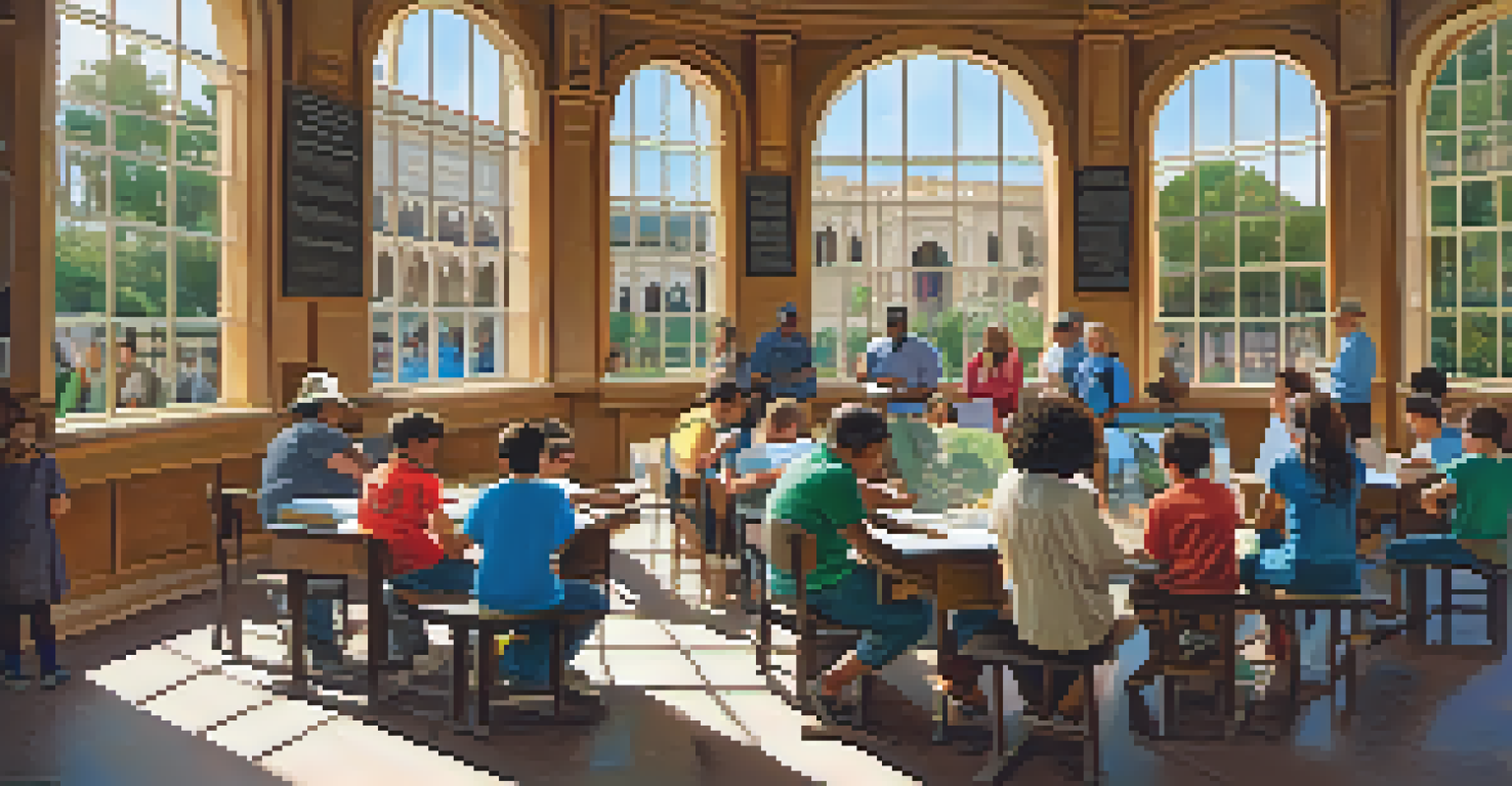The Role of Community Involvement in San Diego Preservation

Understanding Community Involvement in Preservation
Community involvement in preservation refers to the active participation of local residents in protecting and sustaining their cultural and historical resources. In San Diego, this means that citizens don't just observe changes happening in their neighborhoods; they play a vital role in advocating for the preservation of sites that reflect the city’s rich history. This collaborative spirit fosters a sense of ownership and responsibility among residents, leading to more meaningful preservation efforts.
Preservation is not just about protecting the past; it's about creating a future that honors our history.
When communities come together, they not only share their unique stories but also develop a collective vision for their neighborhoods. This can include organizing events, participating in local government meetings, or volunteering for preservation projects. By engaging in these activities, community members build stronger relationships with each other and with their local heritage, creating a network of support that is essential for effective preservation.
Moreover, community involvement provides a platform for diverse voices to be heard. This inclusivity ensures that various perspectives are considered in the preservation process, enhancing the overall impact. When everyone has a stake in the conversation, the outcomes are more likely to reflect the community's true identity and values.
Case Studies of Successful Preservation Initiatives
One notable example of community-driven preservation in San Diego is the restoration of the historic Gaslamp Quarter. Local residents and business owners came together to form the Gaslamp Quarter Association, which played a crucial role in revitalizing the area while maintaining its historical charm. Their efforts not only preserved the architectural integrity of the buildings but also fostered a thriving cultural scene that attracts visitors year-round.

Another inspiring case is the preservation of Balboa Park's historic structures. Community members, along with organizations like the Balboa Park Conservancy, have worked tirelessly to restore and maintain these landmarks. Through fundraising events, volunteer days, and advocacy, they have ensured that future generations can enjoy the park's beauty and history. This collaboration demonstrates how passion and dedication can lead to tangible results.
Community Drives Preservation Efforts
Active participation from local residents is essential for protecting and sustaining cultural and historical resources.
These examples highlight the power of community involvement in preservation efforts. When people unite for a common goal, they can effectively advocate for policies, raise funds, and mobilize resources, ultimately ensuring that their history is not only recognized but celebrated.
The Role of Education in Community Preservation Efforts
Education plays a pivotal role in fostering community involvement in preservation. By informing residents about the historical significance of their neighborhoods, they become more invested in protecting these sites. Workshops, educational programs, and local history tours are excellent ways to engage the community and spark interest in preservation initiatives.
Community involvement is the heart of preservation; when locals unite, they can achieve extraordinary things.
Moreover, schools can be instrumental in teaching students about their local history and the importance of preservation. When young people learn about the cultural heritage of their neighborhoods, they are more likely to become active participants in local preservation efforts as they grow older. This creates a cycle of advocacy that can help sustain preservation initiatives for generations to come.
In addition, community organizations often collaborate with educational institutions to create programs that empower residents. By providing resources and training, these initiatives equip community members with the knowledge and skills they need to take an active role in preserving their heritage.
Challenges Faced by Community Preservation Groups
While community involvement is essential for successful preservation, it is not without challenges. One significant hurdle is the lack of funding for preservation initiatives. Many community groups rely on grants, donations, and fundraising events, which can be inconsistent and unpredictable. Without sufficient financial support, even the most passionate efforts can stall.
Another challenge is resistance from developers and local governments who may prioritize economic growth over historical preservation. This can lead to conflicts between community members who want to protect their heritage and those who seek to modernize or commercialize the area. Navigating these tensions requires strong advocacy and negotiation skills from community members.
Education Fuels Preservation Engagement
Educational initiatives inspire community members to invest in and advocate for their local heritage.
Additionally, sustaining long-term engagement can be difficult. People’s lives are busy, and it can be challenging to maintain momentum in community efforts. To overcome this, successful preservation groups often find creative ways to keep residents involved and motivated, such as hosting regular events or creating social media campaigns to raise awareness.
The Impact of Technology on Community Preservation
Technology has revolutionized how communities approach preservation efforts. Social media platforms, for instance, allow community members to share their experiences and advocate for local preservation on a broader scale. This digital engagement can build momentum and attract new supporters who may not have been aware of preservation issues before.
Moreover, technology enables easier access to information about local history and preservation resources. Websites dedicated to documenting historical sites can provide invaluable data for activists, helping them understand the significance of what they are fighting to protect. Online mapping tools can also help visualize the impact of proposed developments on historic areas.
Furthermore, technology facilitates virtual community meetings and workshops, allowing more people to participate regardless of their schedules or physical locations. This inclusivity can enhance community involvement, ensuring that diverse voices contribute to the preservation conversation.
Building Partnerships for Effective Preservation
Forming partnerships with local organizations, government agencies, and businesses is crucial for successful community preservation efforts. These collaborations can amplify the impact of local initiatives by pooling resources, knowledge, and networks. For instance, a partnership between a community group and a local university can lead to research projects that document and promote the area's history.
Additionally, engaging with local businesses can create a win-win situation: businesses benefit from the increased foot traffic that comes with preserved historical areas, while community groups gain financial support for their preservation efforts. This symbiotic relationship can foster a thriving local economy while ensuring that cultural heritage is respected.
Technology Enhances Preservation Advocacy
Digital tools and social media help communities connect, share information, and mobilize support for preservation initiatives.
By building strong relationships with various stakeholders, community groups can create a more robust framework for advocacy and action. This united front is essential for navigating the complexities of preservation and ensuring that the community's voice is heard in decision-making processes.
The Future of Community Involvement in San Diego Preservation
Looking ahead, the future of community involvement in San Diego preservation appears promising, especially with the growing recognition of the importance of local history. As more residents become aware of the unique stories tied to their neighborhoods, there is likely to be an increase in grassroots efforts aimed at preservation. This enthusiasm can lead to more collaborations and innovative solutions for protecting cultural heritage.
Moreover, as younger generations become more engaged in civic activities, they may bring fresh perspectives and new approaches to preservation. This influx of ideas can rejuvenate established practices and create more inclusive methods of engagement. Embracing this energy is crucial for sustaining preservation efforts in a rapidly changing urban landscape.

Ultimately, the strength of community involvement in San Diego's preservation efforts will depend on the collective commitment to honoring the past while adapting to the future. By fostering collaboration, education, and advocacy, communities can ensure that their rich heritage continues to thrive for years to come.